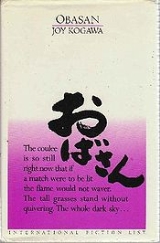
Obasan
Encyclopedia
Obasan is a novel
by the Japanese-Canadian author Joy Kogawa
. First published by Lester and Orpen Dennys in 1981, it chronicles Canada
's internment
and persecution
of its citizens of Japanese
descent during World War II
from the perspective of a young child. This book is often required reading for university English courses on Canadian Literature as well as in Ethnic Studies
and Asian American Literature courses in the United States
. In 2005, it was the One Book, One Vancouver selection.
Kogawa uses strong imagery of silence, stones and streams throughout the novel. Themes depicted in the novel include memory and forgetting, prejudice and tolerance, identity, and justice versus injustice. Kogawa contemplates many of these themes in her poetry as well.
Naomi's narration thus interweaves two stories, one of the past and another of the present, mixing experience and recollection, history and memory throughout. Naomi's struggle to come to terms with both past and present confusion and suffering form the core of the novel's plot.
Although Obasan is fiction, the events, Parliamentary legal documents, and overall notion of racism mirror reality. Through the eyes of fictional characters, Kogawa tells the story of Japanese-Canadians during the Second World War.
Novel
A novel is a book of long narrative in literary prose. The genre has historical roots both in the fields of the medieval and early modern romance and in the tradition of the novella. The latter supplied the present generic term in the late 18th century....
by the Japanese-Canadian author Joy Kogawa
Joy Kogawa
Joy Nozomi Kogawa, CM, OBC is a Canadian poet and novelist of Japanese descent.-Life:Born Joy Nozomi Nakayama in Vancouver, British Columbia, she was sent with her family to the internment camp for Japanese Canadians at Slocan during World War II...
. First published by Lester and Orpen Dennys in 1981, it chronicles Canada
Canada
Canada is a North American country consisting of ten provinces and three territories. Located in the northern part of the continent, it extends from the Atlantic Ocean in the east to the Pacific Ocean in the west, and northward into the Arctic Ocean...
's internment
Japanese Canadian internment
Japanese Canadian internment refers to confinement of Japanese Canadians in British Columbia during World War II. The internment began in December 1941, following the attack by carrier-borne forces of Imperial Japan on American naval and army facilities at Pearl Harbor...
and persecution
Persecution
Persecution is the systematic mistreatment of an individual or group by another group. The most common forms are religious persecution, ethnic persecution, and political persecution, though there is naturally some overlap between these terms. The inflicting of suffering, harassment, isolation,...
of its citizens of Japanese
Japanese people
The are an ethnic group originating in the Japanese archipelago and are the predominant ethnic group of Japan. Worldwide, approximately 130 million people are of Japanese descent; of these, approximately 127 million are residents of Japan. People of Japanese ancestry who live in other countries...
descent during World War II
World War II
World War II, or the Second World War , was a global conflict lasting from 1939 to 1945, involving most of the world's nations—including all of the great powers—eventually forming two opposing military alliances: the Allies and the Axis...
from the perspective of a young child. This book is often required reading for university English courses on Canadian Literature as well as in Ethnic Studies
Ethnic studies
Ethnic studies is the interdisciplinary study of racialized peoples in the world in relation to ethnicity. It evolved in the second half of the 20th century partly in response to charges that traditional disciplines such as anthropology, history, English, ethnology, Asian studies, and orientalism...
and Asian American Literature courses in the United States
United States
The United States of America is a federal constitutional republic comprising fifty states and a federal district...
. In 2005, it was the One Book, One Vancouver selection.
Kogawa uses strong imagery of silence, stones and streams throughout the novel. Themes depicted in the novel include memory and forgetting, prejudice and tolerance, identity, and justice versus injustice. Kogawa contemplates many of these themes in her poetry as well.
Plot
Set in 1972, Obasan centres on the memories and experiences of Naomi Nakane, a 36 year old schoolteacher living in the rural Canadian town of Cecil, Alberta, when the novel begins. The death of Naomi's uncle, with whom she had lived as a child, leads Naomi to visit and care for her widowed aunt Aya, whom she refers to as Obasan (Obasan being the Japanese word for "Aunt" in this context). Her brief stay with Obasan in turn becomes an occasion for Naomi to revisit and reconstruct in memory her painful experiences as a child during and after World War II, with the aid of a box of correspondence and journals sent to her by her Aunt Emily, detailing the years of the measures taken by the Canadian government against the Japanese citizens of Canada and their aftereffects. With the aid of Aunt Emily's box, Naomi learns that her mother, who had been in Japan before the bombing of Pearl Harbor, was severely injured by the atomic bomb dropped on Nagasaki and l; a finding which changes her perspective of the 'War in the Pacific', and rekindles the heartbreak she experienced as a child.Naomi's narration thus interweaves two stories, one of the past and another of the present, mixing experience and recollection, history and memory throughout. Naomi's struggle to come to terms with both past and present confusion and suffering form the core of the novel's plot.
Although Obasan is fiction, the events, Parliamentary legal documents, and overall notion of racism mirror reality. Through the eyes of fictional characters, Kogawa tells the story of Japanese-Canadians during the Second World War.

